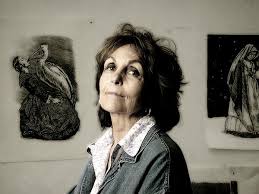 Paula Rego was suggested to me by one of my tutors. I really like her work, more the stories behind them than the actual pieces themselves. I love how big, chunky, and real her figures are. It makes me feel better about my work since it is rather illustrative. I find it hard because the word 'illustration' is used in a negative context by many people, which is silly because illustration is art. And all it is is telling a story which all art does. There is always a story behind a painting/piece of artwork no matter what its about.
Paula Rego was suggested to me by one of my tutors. I really like her work, more the stories behind them than the actual pieces themselves. I love how big, chunky, and real her figures are. It makes me feel better about my work since it is rather illustrative. I find it hard because the word 'illustration' is used in a negative context by many people, which is silly because illustration is art. And all it is is telling a story which all art does. There is always a story behind a painting/piece of artwork no matter what its about.
I like to tell stories, I am not a very good verbal storyteller, I leave that one to my grandpa. I tell stories through my art.
Below are some images of her paintings and a short biography that I got from the website, http://www.jahsonic.com/PaulaRego.html.
The images are from the website http://www.saatchi-gallery.co.uk/artists/paula_rego.htm
 |
| 'Swallows the poison Apple' |
In Swallows The Poison Apple, Paula Rego revises the tale of Snow White to expose the fallible value of youth. Dressed in traditional Disney garb, this Snow White isn’t a beautiful princess, but a middle-aged woman. Pictured moments after eating the poison apple, she lays sprawled amidst overturned furniture, suggesting painful and violent demise. Clutching her skirts, she alludes to her sexual nature, as if clinging to something slipping away. Her body lies between a blanket adorned with spring blossoms, and a sinister backdrop of red and black. Rego illustrates the conflict of reality encroaching on the socially imposed myths of female worth, construing aging as both a physical and psychological violation.
 |
| 'Snow White playing with her fathers trophies' |
Drawing from her own childhood memories, Paula Rego’s work illustrates corrupted folklore, where fairytale and horror converge to portray feminine experience. Recalling childhood visits to the movies with her father, Rego’s Snow White series appropriates the Disney story with unnerving fictional and autobiographical twists. In Snow White Playing With Her Father’s Trophies, Rego uses the allegory of female vanity to underlie a familial politic. The heroine, pictured in a white dress symbolising virginity and innocence, seems wryly aware of her own sexuality. Sat unladylike with legs spread, she prizes the head of a young buck between her knees, representing sexual awakening and insinuating improper affection towards her father. In the background, her stepmother kneels as aging witch, looking on with scorn and envy.  |
| 'Celestina's House' |
The picture begins with the story of Celestina, a character who appears in Spanish literature in the late fifteen century. Celestina was a procures and Paula Rego draws her as she draws all her women – tough, practical, ruthless. The picture uses the story of Celestina to explore the ages of women, although as Paula Rego wryly comments, if there are seven ages of woman as of man, then her Celestina has already lived through at least thirteen.
Biography
Paula Rego (born 1935) is a Portuguese painter, illustrator and print maker.
Born in Lisbon, Rego was sent to finishing school in Sevenoaks in England. She left to the Slade School of Art where she met the artist Victor Willing, whom she eventually married. The two divided their time between Portugal and England until 1975, when they moved to England. Willing later died after suffering for some years from multiple sclerosis.
Rego has stated that illustrative art (such as that in the Beatrix Potter books) and fairy tales were important early influences. Her work sometimes includes imagery from fairy tales with a sinister edge. Early pieces sometimes use collaged elements taken from Rego's own drawings, with later works often being in vinyl paint on paper.
Rego's style is often compared to cartoon illustration. As in cartoons, animals are often depicted in human roles and situations. Later work adopts a more realistic style, but sometimes keeps the animal references - the Dog Woman series of the 1990s, for example, is a set of pastel pictures depicting women in a variety of dog-like poses (on all fours, baying at the moon, and so on).
Rego has also painted a portrait of Germaine Greer, which is in the National Portrait Gallery in London. Rego was shortlisted for the Turner Prize in 1989

No comments:
Post a Comment